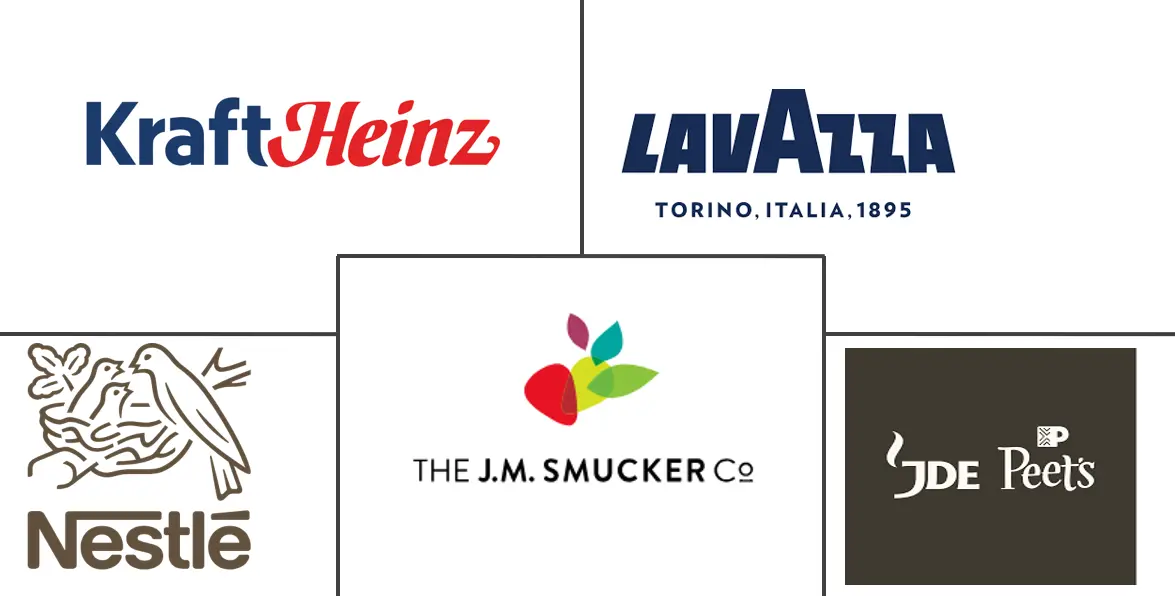Instant Coffee Market Size and Share

Instant Coffee Market Analysis by Mordor Intelligence
The global instant coffee market attained a value of USD 36.73 billion in 2025 and is projected to reach USD 48.17 billion by 2030, exhibiting a CAGR of 5.57%. The market expansion is primarily attributed to the transformation in consumer preferences, specifically the increased demand for convenient, premium coffee products that accommodate contemporary lifestyles. Premium single-origin instant coffee variants have established a significant market presence, addressing the requirements of consumers who prioritize quality and convenience. Advanced freeze-drying technologies have substantially improved the preservation of flavor and aroma characteristics in instant coffee products, facilitating the market's premium segment development. Furthermore, market growth is augmented by the heightened coffee consumption patterns among younger demographic segments, progressive urbanization, and the proliferation of e-commerce platforms, which enhance the distribution and accessibility of diverse instant coffee products in the instant coffee market.
Key Report Takeaways
- By flavoring, unflavored coffee held 84.92% of the instant coffee market share in 2024, whereas flavored coffee is set to expand at 7.61% CAGR to 2030.
- By production technology, spray-dried variants led with 63.49% revenue share in 2024; freeze-dried products are on track for a 7.31% CAGR through 2030.
- By price tier, the mass segment commanded 82.67% of the instant coffee market size in 2024, while the premium tier is forecast to climb 9.19% CAGR between 2025-2030.
- By packaging, jars accounted for a 58.43% share of the instant coffee market size in 2024, yet sachets are the fastest grower at 6.41% CAGR through 2030.
- By distribution, supermarkets/hypermarkets captured 51.83% of the instant coffee market share in 2024; online retail is the quickest riser with a 9.08% CAGR to 2030.
- By region, Asia-Pacific dominated with a 38.35% revenue share in 2024, while South America posts the highest regional CAGR at 10.92% for 2025-2030.
Global Instant Coffee Market Trends and Insights
Drivers Impact Analysis
| Driver | (~) % Impact on CAGR Forecast | Geographic Relevance | Impact Timeline |
|---|---|---|---|
| Rising demand for premium single-origin instant coffee | +1.8% | North America, Europe, Urban Asia-Pacific | Medium term (2-4 years) |
| Technological advances in freeze-drying | +1.5% | Global, with concentration in Japan, Europe, North America | Medium term (2-4 years) |
| Increasing penetration of ready-to-mix coffee for on-the-go consumption | +1.2% | Global, with emphasis on urban centers across all regions | Short term (≤ 2 years) |
| Strategic capacity expansion by soluble coffee exporters | +0.9% | South America, Southeast Asia, with global market impact | Long term (≥ 4 years) |
| Expansion of retail channels and e-commerce platforms improves product accessibility | +0.7% | Global, with higher impact in emerging markets | Short term (≤ 2 years) |
| Growing café culture influences at-home coffee consumption habits | +0.6% | Urban centers globally, particularly Asia-Pacific and North America | Medium term (2-4 years) |
| Source: Mordor Intelligence | |||
Rising Demand for Premium Single-Origin Instant Coffee
The premium single-origin segment is fundamentally restructuring the global instant coffee market through substantial shifts in consumer preferences and market dynamics. Market analysis demonstrates a pronounced transition toward traceable, high-quality products with distinctive flavor characteristics, indicating a significant evolution in instant coffee purchasing behavior. This transformation is particularly evident among younger demographic segments, with the National Coffee Association reporting an 18% increase in specialty coffee consumption since 2020, reaching 46% of American adults by January 2025 [1]Source: National Coffee Association, "National Coffee Data Trends", www.ncausa.org. According to the International Coffee Organization's comprehensive market analysis, specialty coffee markets exhibit growth trajectories substantially exceeding the industry average, subsequently influencing product development initiatives and strategic market positioning within the global instant coffee segment of the instant coffee market.
Technological Advances in Freeze-Drying
Technological advancements are driving the global instant coffee market's growth, especially as consumers increasingly favor convenience and café-style experiences at home. A prime example is Nestlé’s June 2025 launch of freeze-dried, cold-soluble coffee products, including Nescafé Ice Roast and Nescafé Espresso Concentrate. These products cater to the rising demand for cold coffee formats among Gen Z and millennial consumers. Nestlé, utilizing patented freeze-drying and nitrogen-infusion technology, ensures flavor integrity and solubility in cold liquids, an innovation that addresses a major limitation of traditional instant coffee. Supporting this trend, data from the United States Department of Agriculture indicates that in 2024/25, premium green coffee constituted over 60% of China’s coffee imports, surpassing traditional soluble coffee consumption [2]Source: United States Department of Agriculture, "China’s Expanding Coffee Consumption", www.usda.gov . This shift highlights a global coffee culture transformation, with consumers, particularly in emerging markets, leaning towards higher-quality, origin-specific, and freshly brewed experiences. In light of this, instant coffee manufacturers are enhancing their technologies to deliver these premium experiences in more convenient formats. This evolution emphasizes how heightened consumer sophistication, combined with technological strides in freeze-drying, flavor encapsulation, and cold-brew compatibility, is reshaping the instant coffee landscape and fueling its global growth in the instant coffee market.
Increasing Penetration of Ready-to-Mix Coffee for On-the-Go Consumption
The global instant coffee market demonstrates sustained expansion, primarily attributed to increasing consumer demand for convenient beverage solutions, particularly in traditionally tea-consuming regions and among younger demographic segments seeking efficient preparation methods while maintaining product quality. According to the National Coffee Association's analysis, 66% of American adults consume coffee daily, with an average consumption rate of 3 cups per person. Household instant coffee ownership exhibited significant growth, increasing from 27% in 2020 to 35% in 2025. The association's comprehensive assessment indicates that 71% of coffee consumers prepare their beverages at home, with grocery retail establishments maintaining their position as the predominant purchase channel. In India, instant coffee represents 60-65% of total coffee consumption, with urban regions exhibiting higher consumption patterns due to product accessibility and cost-effectiveness, as documented by the Coffee Board in the instant coffee market.
Strategic Capacity Expansion by Soluble Coffee Exporters
Global demand for convenient, high-quality coffee, particularly in emerging markets, is driving soluble coffee exporters to expand their production capacity. Urbanization and rising disposable incomes in Asia-Pacific, Africa, and South America are transforming consumption patterns, making these regions the fastest-growing markets for coffee consumption. Exporters are upgrading their production facilities with advanced manufacturing technologies, including automated quality control systems, energy-efficient drying equipment, and water conservation systems, to improve operational efficiency and meet sustainability requirements. The expansion also focuses on diversifying product portfolios with premium and specialty instant coffees, including freeze-dried and plant-based options, to address consumer preferences for personalized and health-conscious products. Tanzania's Coffee Industry Development Strategy (2020-2025) exemplifies this trend, aiming to increase national production to 300,000 metric tons by 2025/26 through improved seedling distribution and processing technology investments. These developments reflect the industry's focus on capacity expansion and innovation in product development and supply chain management to sustain growth in the global soluble coffee market, contributing to the instant coffee market.
Restraints Impact Analysis
| Restraint | (~) % Impact on CAGR Forecast | Geographic Relevance | Impact Timeline |
|---|---|---|---|
| Climate-induced yield volatility raising costs | -1.2% | Global, with severe impact in Brazil, Vietnam, Colombia | Medium term (2-4 years) |
| Presence of substitutes hampering market growth | -0.8% | North America, Europe, Urban Asia-Pacific | Long term (≥ 4 years) |
| Competition from specialty coffee shops | -0.6% | Urban centers globally, particularly developed markets | Medium term (2-4 years) |
| Supply chain disruptions | -0.5% | Global, with higher impact on import-dependent markets | Short term (≤ 2 years) |
| Source: Mordor Intelligence | |||
Climate-Induced Yield Volatility Raising Costs
Climate change disruptions in coffee production economics pose significant operational challenges for the instant coffee market. Extreme weather events have led to notable price volatility across the value chain, influencing both production costs and market balance. The Food and Agriculture Organization reported that adverse weather in key producing nations led to a 38.8% spike in coffee prices in 2024 [3]Source: Food and Agriculture Organization, "Adverse climatic conditions drive coffee prices to highest level in years", www.fao.org. This surge was particularly pronounced in Arabica prices, which jumped by 58%. Meanwhile, Robusta prices, crucial for instant coffee production, saw an even steeper rise of 70%. These price increases have a cascading effect on the entire value chain, from raw material procurement to final product pricing, making it difficult for manufacturers to absorb costs without impacting profitability. Additionally, supply chain uncertainties, such as delays in transportation, disruptions in sourcing raw materials, and logistical inefficiencies, further exacerbate the challenges. Production capacity limitations, driven by both resource constraints and increased operational costs, add another layer of complexity. Furthermore, manufacturers face difficulties in forecasting demand accurately due to fluctuating prices and inconsistent supply, which can lead to overproduction or underproduction. Together, these factors create considerable hurdles for instant coffee producers striving to maintain consistent output, ensure product availability, and sustain competitive market positioning in the instant coffee market.
Presence of Substitutes Hampering Market Growth
As substitutes and low-caffeine alternatives become more available and preferred, the global instant coffee market grapples with mounting challenges. With health and wellness trends on the rise, many consumers are cutting back on caffeine. This shift has spurred demand for decaffeinated coffee, herbal teas, mushroom-based drinks, and caffeine-free functional beverages. These alternatives, often viewed as healthier and more natural, resonate particularly with younger, health-conscious consumers and those embracing holistic lifestyles. Furthermore, the surge in ready-to-drink (RTD) beverages, especially plant-based and adaptogenic ones, presents a convenient rival to instant coffee, boasting distinct health claims. The expanding array of beverage choices has heightened competition, challenging traditional instant coffee brands to maintain their market share. This is especially true in regions where innovation and transparency on labels sway purchasing decisions. Additionally, consumers in search of variety and novelty are more inclined to visit specialty cafés or opt for RTD beverages, steering away from standard instant products. Consequently, the rise of substitutes and low-caffeine options is not only eroding brand loyalty within the instant coffee realm but also compelling manufacturers to rethink, reposition, and diversify their products to remain pertinent in a shifting beverage market , especially within the instant coffee market.
Segment Analysis
By Flavoring: Unflavored Dominates While Flavored Accelerates
Unflavored instant coffee commands 84.92% of the market share in 2024, establishing itself as the foundation of the instant coffee industry through its versatility and broad consumer acceptance. The segment's dominance is reflected in traditional coffee markets like Brazil, where the United States Department of Agriculture (USDA) forecasts total coffee production for marketing year 2025/26 (July-June) at 65 million bags (60 kilograms per bag) green bean equivalent, representing a 0.5% increase from the 2024/2025. The flavored instant coffee segment is expected to grow at a CAGR of 7.31% from 2025 to 2030, as manufacturers respond to evolving consumer preferences, particularly among younger demographics seeking diverse taste experiences.
The growth in flavored instant coffee reflects changing consumer tastes. Products including vanilla, caramel, hazelnut, mocha, and seasonal variants provide alternatives to conventional coffee offerings. These options particularly resonate with younger consumers who demonstrate increased interest in experimenting with flavor combinations. The range of choices enables instant coffee to reach consumers beyond traditional coffee drinkers. Manufacturers are creating new flavor profiles that blend traditional coffee characteristics with flavored beverages to increase market penetration in the instant coffee market. The segment's growth is supported by advances in flavor encapsulation technologies that better preserve aromas during the drying process, resulting in more authentic flavors that rival fresh-brewed coffee.
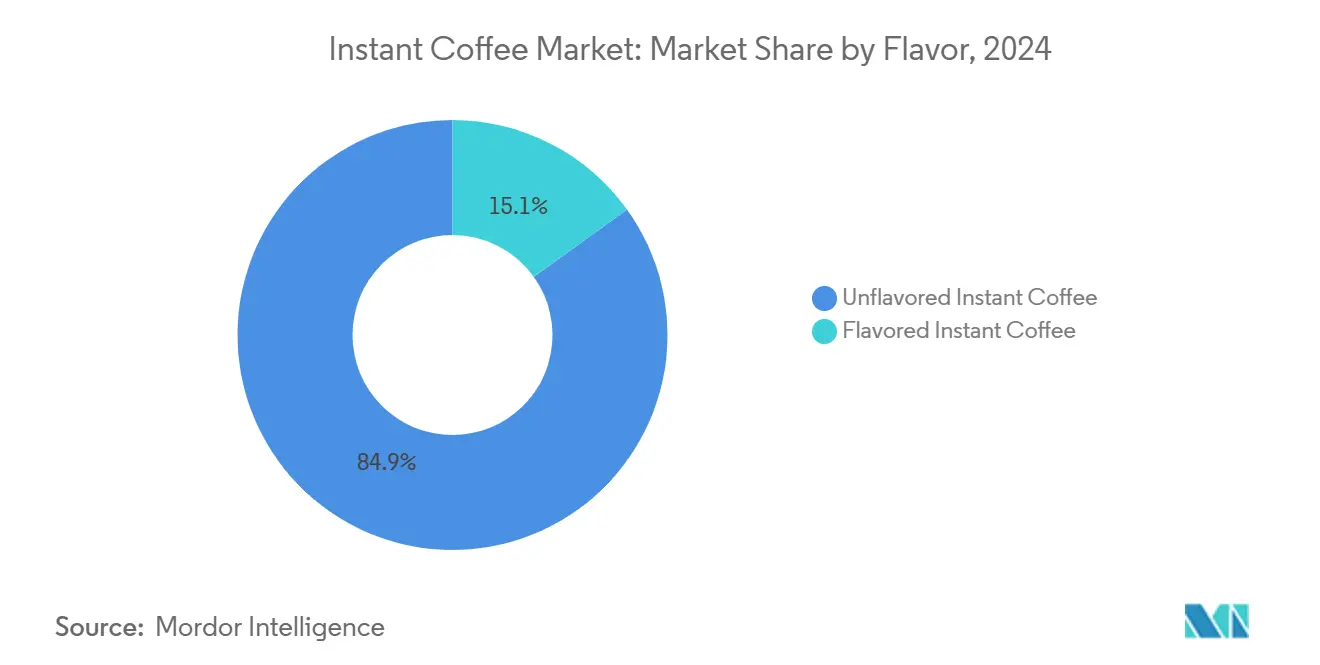
Note: Segment shares of all individual segments available upon report purchase
By Production Technology: Freeze-Dried Quality Challenges Spray-Dried Dominance
Spray-dried technology held 63.49% revenue in 2024, owing to low running costs and legacy plant footprints. Still, freeze-dried variants are outpacing with a 7.31% CAGR from 2025 to 2030 as shoppers trade up for richer aroma. To adapt to these changing consumer preferences and intensifying competition, manufacturers are turning to advanced technologies for product enhancement and differentiation. A prime example in 2024 is Ofi’s new soluble coffee facility in Brazil, where the company is championing sustainable innovation through Spray-Freeze Drying (SFD) technology. This SFD technology melds the operational efficiency of spray drying with the superior sensory qualities of freeze drying. Additionally, it promotes nanobubble formation, bolstering foam stability, a crucial factor in consumer experience and acceptance, as highlighted by research in Food and Bioprocess Technology. By improving the sensory appeal and overall quality of instant coffee, this technology addresses consumer demand for premium products.
Furthermore, the facility’s focus on sustainability aligns with the increasing consumer preference for environmentally responsible practices, adding another layer of differentiation. Such technological strides are vital for the instant coffee segment, enabling it to bridge the quality gap and present premium alternatives that resonate with a discerning global audience in the instant coffee market. These innovations not only help retain existing consumers but also attract new ones who might otherwise opt for substitutes in the instant coffee market.
By Price: Premium Segment Outpaces Mass Market Growth
The global instant coffee market demonstrates distinct price segmentation, with the mass market segment maintaining 82.67% market share in 2024. This position results from comprehensive distribution networks and established consumer presence in international markets. The premium and specialty segment, despite its smaller market share, demonstrates a 9.19% CAGR during 2025-2030, surpassing the overall market growth rate. This expansion indicates a significant shift in consumer preferences and increased allocation of disposable income toward premium coffee products, particularly in established markets.
The premium segment's growth is transforming market dynamics, compelling organizations to implement strategic innovations in product formulation, packaging solutions, and marketing initiatives to establish premium pricing structures and enhance international market presence in the instant coffee industry. Organizations are implementing strategic expansions of their premium product portfolios to address evolving consumer requirements. In February 2025, Starbucks Corporation expanded its international product portfolio through the introduction of Starbucks Crema Collection Premium Instant, a specialized coffee line developed for residential consumption, accommodating both hot and cold preparation methodologies in the instant coffee market.
By Distribution Channel: E-commerce Disrupts Traditional Retail Dominance
Supermarkets and hypermarkets constitute 51.83% of instant coffee distribution channels in 2024, attributed to their extensive distribution networks, comprehensive product portfolios, and established consumer purchasing behaviors. The online retail segment demonstrates substantial expansion at a 9.08% CAGR from 2025 to 2030, exceeding traditional retail distribution performance. The National Coffee Association reports that online coffee purchases increased from 7% to 14% between 2020 and 2025, indicating a significant transformation in consumer purchasing patterns.
Convenience stores and grocery establishments maintain their strategic importance for immediate purchases and consumption requirements, particularly in densely populated urban locations. Specialty stores, despite their limited market share, function as critical entry points for premium and niche instant coffee products, subsequently influencing market dynamics. Distribution channel preferences exhibit regional variations, with traditional retail maintaining prominence in developing markets while digital channels predominate in established instant coffee markets with superior internet infrastructure. Manufacturing entities, including Nestlé, are implementing comprehensive omnichannel strategies to integrate physical and digital distribution networks, encompassing digital consumer engagement programs and subscription-based services across the instant coffee industry.
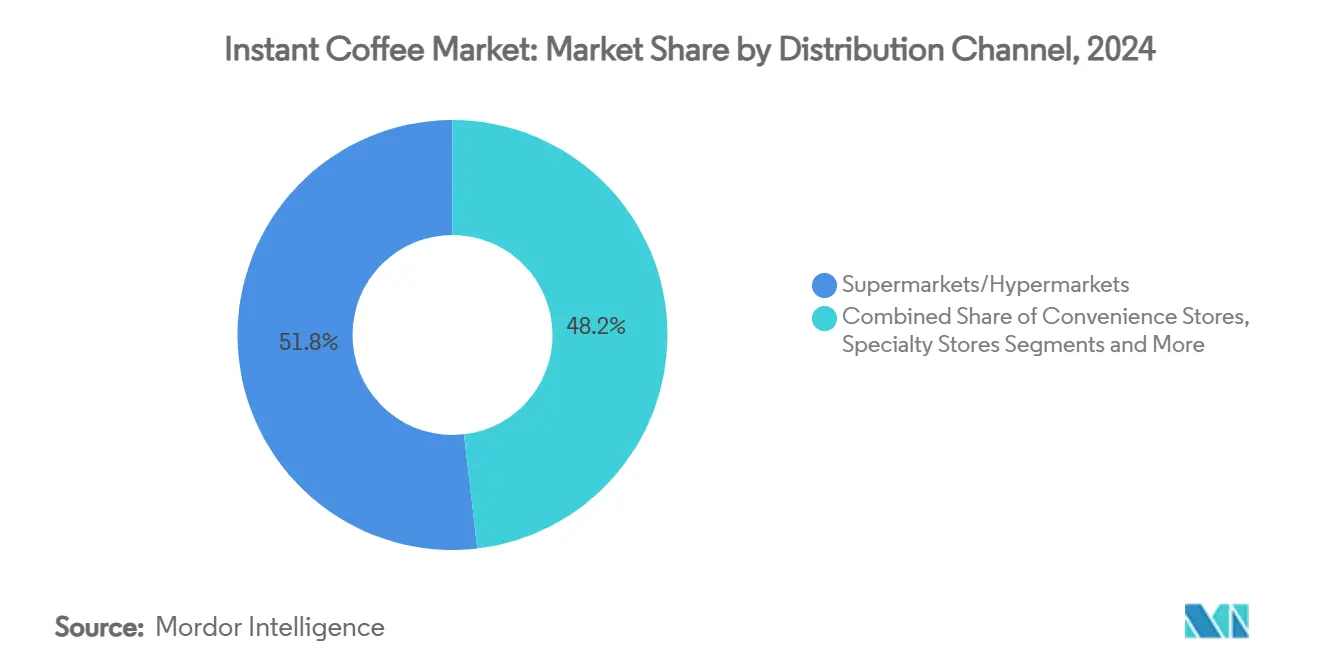
Note: Segment shares of all individual segments available upon report purchase
By Packaging Format: Convenience Drives Sachet Growth Despite Jar Dominance
The evolution of packaging formats significantly influences consumer engagement with instant coffee products. Glass jars maintain market dominance with a 58.43% share in 2024 in the instant coffee market, attributed to their established value proposition, reusability characteristics, and widespread consumer acceptance. Sachets, particularly single-serve, demonstrate the highest growth trajectory at 6.41% CAGR from 2025 to 2030, primarily due to their operational efficiency, precise portion control capabilities, and alignment with mobile consumption patterns. The sachet format has established a substantial market presence in developing regions by providing cost-effective entry points for new consumers and addressing the requirements of urban professionals seeking efficient coffee solutions.
Sustainability has emerged as a fundamental consideration in packaging development, exemplified by Nestlé's strategic initiatives to minimize virgin plastic utilization and optimize energy efficiency in packaging operations. Pouches function as an intermediate market solution between traditional jars and sachets, effectively balancing convenience and volume requirements while delivering enhanced product preservation capabilities. The packaging landscape continues to advance through material innovations, structural design optimizations, and functional improvements that enhance user experience while addressing environmental imperatives in the instant coffee industry.
Geography Analysis
Asia-Pacific holds a 41.15% share of the instant coffee market in 2024, driven by rapid urbanization, rising disposable incomes, and evolving coffee cultures. According to the United States Department of Agriculture (USDA), Chinese consumers used approximately 5.8 million 60-kilogram bags of coffee between 2023 and 2024. The Chinese market has shifted toward higher-quality green coffee, which now represents over 60% of imports. In India, coffee consumption exceeded one million 60-kilogram bags between 2023 and 2024, as reported by the United States Department of Agriculture (USDA).
South America is experiencing the fastest regional growth at 8.85% CAGR (2025-2030), with Brazil transitioning from a traditional producer to a major consumer market. According to Brazil's National Supply Company, coffee production reached 58.81 million 60-kilogram bags in 2024, increasing from 55.07 million bags in 2023. The region's expansion stems from rising domestic consumption, capacity expansions, and increased focus on value-added processing.
North America and Europe maintain stable market positions with established coffee cultures. The National Coffee Association indicates that 66% of American adults consume coffee daily, averaging 3 cups per person. Household instant coffee ownership increased from 27% in 2020 to 35% in 2025. The Middle East and Africa, while holding a smaller market share, demonstrate growth potential through developing coffee cultures and increasing urbanization in the instant coffee industry.
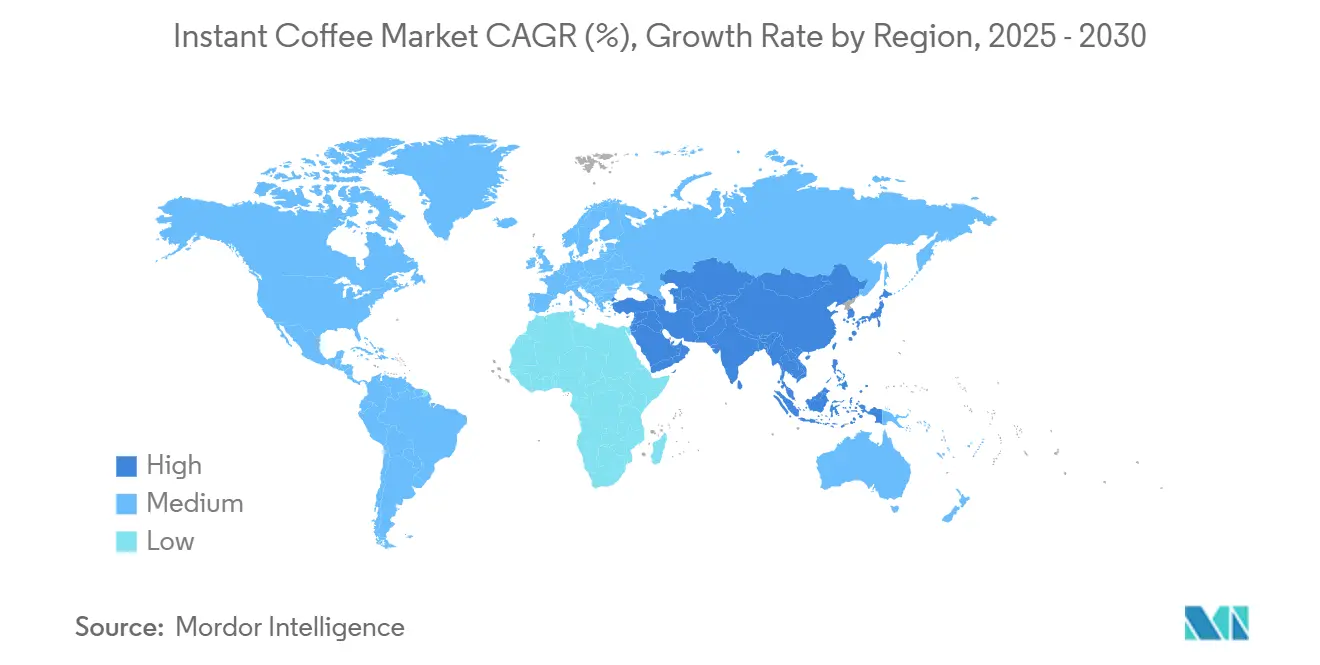
Competitive Landscape
The global instant coffee market exhibits a fragmented structure, characterized by the predominant presence of multinational corporations including Nestle S.A., J.M. Smucker Company, Luigi Lavazza S.p.A., Starbucks Corporation, and The Kraft Heinz Company. These organizations maintain their market leadership positions through comprehensive product portfolios, established global distribution networks, and substantial research and development investments. The market landscape continues to transform strategic consolidation activities, particularly mergers and acquisitions, which significantly influence competitive dynamics.
In response to market consolidation, smaller market participants have established differentiated positions through specialized product offerings, regional market expertise, and innovative operational models to maintain their competitive standing. Market leaders are implementing strategic initiatives that emphasize premium product development, sustainability programs, and technological advancement to enhance product quality and optimize consumer satisfaction levels. These initiatives demonstrate the industry's commitment to meeting evolving consumer requirements while maintaining operational excellence in the instant coffee industry.
The market presents significant opportunities in functional instant coffee formulations that incorporate health benefits, sustainable packaging innovations, and direct-to-consumer distribution models that bypass traditional retail channels. Industry participants are making substantial investments in advanced production methodologies, with particular emphasis on spray-freeze drying technology, to enhance product quality and address increasingly sophisticated consumer preferences across the instant coffee industry. These technological advancements represent a critical component in the industry's ongoing development.
Instant Coffee Industry Leaders
-
Nestle S.A.
-
J.M. Smucker Company
-
Kraft Heinz Company
-
Luigi Lavazza S.p.A.
-
JDE Peet's N.V.
- *Disclaimer: Major Players sorted in no particular order
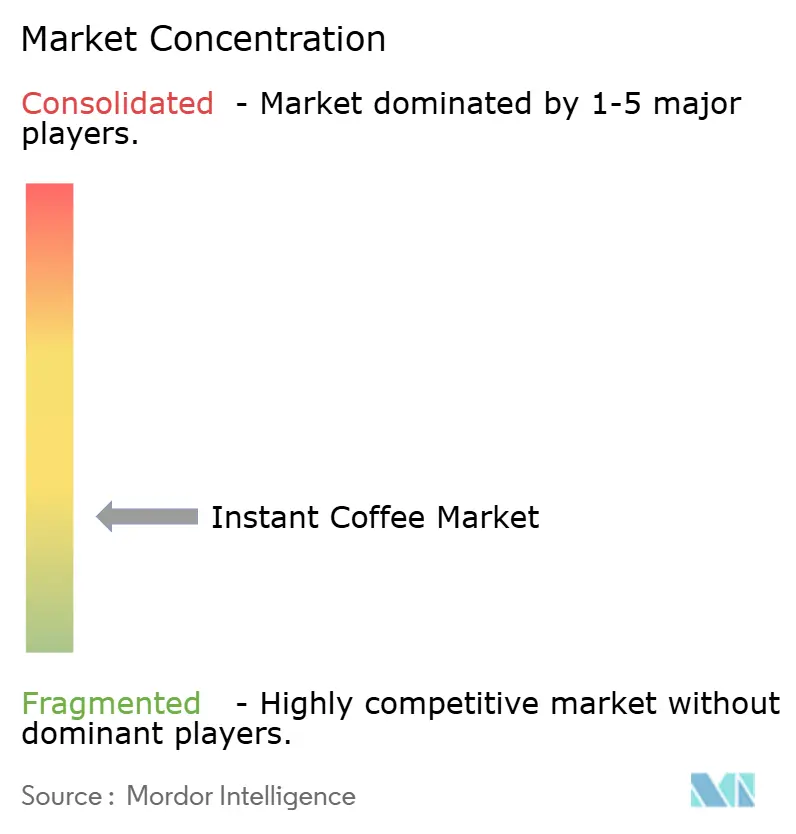
Recent Industry Developments
- May 2025: Nesil Coffee expanded its instant coffee product range by introducing three new flavors: hazelnut, pistachio, and pumpkin. The company sources coffee beans from Europe, Ethiopia, Tanzania, Colombia, and Guatemala.
- May 2025: Continental Coffee expanded its premium instant coffee brand, Continental Spéciale, by introducing four flavored instant coffee variants: Mocha, Vanilla, Caramel, and Hazelnut. These additions represent the company's first venture into flavored coffee products, marking its strategic expansion in India's growing flavored coffee segment.
- February 2025: Starbucks introduced the Crema Collection Premium Instant coffee line featuring three flavors: Salted Caramel, Madagascar Vanilla, and Molten Chocolate.
- January 2025: Nestle S.A. introduced Nescafe Gold Blend Caffeine Half, an instant coffee product containing 50% less caffeine than regular coffee. The product addresses consumer demand for reduced caffeine options and is available in 20-stick packs.
Research Methodology Framework and Report Scope
Market Definitions and Key Coverage
Our study defines the instant coffee market as soluble powders, granules, or agglomerates produced by spray-drying or freeze-drying roasted beans, designed to dissolve completely in water or milk for immediate drinking. Sales are captured at manufacturer selling price across retail, e-commerce, food-service, and institutional channels worldwide.
Scope Exclusions: Ready-to-drink coffee, coffee concentrates, and single-serve pod systems lie outside this assessment.
Segmentation Overview
- By Flavoring
- Flavored Instant Coffee
- Unflavored Instant Coffee
- By Production Technology
- Spray-Dried Instant Coffee
- Freeze-Dried Instant Coffee
- By Price
- Mass
- Premium
- By Packaging Format
- Sachets
- Pouches
- Jars
- By Distribution Channel
- Supermarkets/Hypermarkets
- Convenience/Grocery Stores
- Specialty Stores
- Online Retail
- Other Distribution Channels
- By Geography
- North America
- United States
- Canada
- Mexico
- Rest of North America
- Europe
- Germany
- United Kingdom
- France
- Italy
- Spain
- Russia
- Rest of Europe
- Asia-Pacific
- China
- India
- Japan
- South Korea
- Australia
- Southeast Asian countries
- Rest of Asia-Pacific
- South America
- Brazil
- Argentina
- Colombia
- Rest of South America
- Middle East and Africa
- Saudi Arabia
- United Arab Emirates
- Turkey
- South Africa
- Kenya
- Nigeria
- Rest of Middle East and Africa
- North America
Detailed Research Methodology and Data Validation
Primary Research
Analysts interviewed plant managers, procurement heads at roasters, distributors, and retail buyers across Asia-Pacific, Europe, the Americas, and MENA. Discussions clarified average selling prices, pack-size shifts, flavoring uptake, and emerging premium cues, which were critical for cross-checking model drivers and refining regional weightings.
Desk Research
We mapped production, trade, and consumption patterns through open datasets such as FAOSTAT, UN Comtrade, the International Coffee Organization, Eurostat, and national coffee boards; these sources framed supply fundamentals and regional demand pools. Company filings, 10-Ks, investor decks, and reputable business media enriched pricing insight and brand reach. Where granular shipment or corporate revenue splits were vital, Mordor analysts extracted indicative figures from D&B Hoovers and Volza. Many additional public and subscription resources supported fact-checks and contextual depth.
Market-Sizing & Forecasting
A top-down construct begins with green-bean output and import balances, converts edible beans to soluble-coffee yield using technology-specific extraction ratios, and layers channel penetration rates to value the demand pool. Select bottom-up roll-ups of leading producers' disclosed instant-coffee revenues act as guardrails. Key variables like spray- versus freeze-dry capacity, single-serve sachet adoption, instant share of total coffee cups, and average retail price per kg feed a multivariate regression that projects growth. Expert consensus on urban convenience trends and premiumization underpins scenario testing. ARIMA checks were applied to flag aberrations before locking the base case.
Data Validation & Update Cycle
Outputs pass variance checks versus ICO consumption tallies and customs trade flows; anomalies trigger re-interviews and senior review. Reports refresh each year, with interim tweaks when currency swings or crop shocks materially alter assumptions.
Why Mordor's Instant Coffee Baseline Earns Unmatched Credibility
Published estimates often differ because firms choose distinct product baskets, price conversions, and refresh cadences.
Key gap drivers include whether mixes and concentrates are folded into scope, if retail and food-service volumes are blended, the aggressiveness of sachet price escalation, and the frequency at which datasets are re-benchmarked to new crop statistics.
Benchmark comparison
| Market Size | Anonymized source | Primary gap driver |
|---|---|---|
| USD 36.73 B (2025) | Mordor Intelligence | - |
| USD 84.61 B (2025) | Global Consultancy A | Includes RTD coffees and coffee mixes; limited primary price checks |
| USD 14.70 B (2024) | Trade Journal B | Counts only spray-dried formats; excludes institutional channels |
The comparison shows how broader or narrower product definitions and fewer validity loops can swing headline values widely. By anchoring volumes to audited trade data, validating prices with buyers, and refreshing models annually, Mordor Intelligence delivers a balanced, transparent baseline decision-makers can trust.
Key Questions Answered in the Report
What is the current size of the instant coffee market?
The instant coffee market size stands at USD 34.94 billion in 2025 and is projected to reach USD 46.02 billion by 2030 at a 5.66% CAGR.
Which region leads global sales?
Asia-Pacific holds the lead with 41.15% of worldwide revenue, driven by fast-growing coffee cultures in China and India.
Why is freeze-dried instant coffee growing faster than spray-dried?
Freeze-drying preserves more aroma and bioactive compounds, meeting consumer expectations for café-level taste and fuelling a 7.61% CAGR for this technology.
How are e-commerce channels affecting instant coffee sales?
E-commerce channels are accelerating instant coffee sales by enhancing accessibility, variety, and convenience, contributing to a projected CAGR of 9.22%.
Page last updated on:
